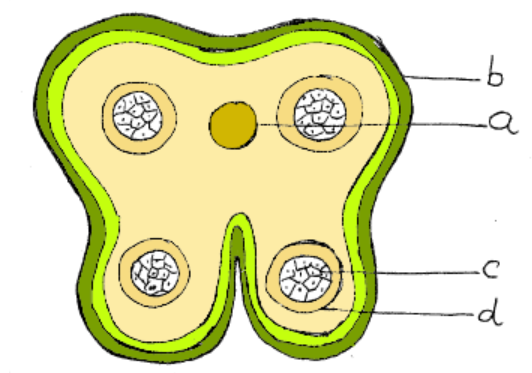
The diagram given below shows the transverse section of a young anther. Identify the parts a, b, c and d


Answer
557.4k+ views
Hint: The anther is that part of the flower that contains the pollen. It is located at the top of the filament. The anther is made up of two lobes that are connected by tissue. This tissue comprises another type of tissue that helps in the production of pollen. Anther also contains certain elements that provide nutrition to the developing grains.
Complete answer:
The correct answer is:
> Connective tissue
> Epidermis
> Micro Sporogenous tissue
> Tapetum
The anther is located at the top of the filament and is part of the stamen. Most of the anthers are bilobed (dithecous), however, some may have a single lobe only (monothecous).
CONNECTIVE TISSUE
The connective tissue is a sterile tissue that is present between the two lobes of the anther. It basically connects the two lobes, hence the name.
EPIDERMIS
The outermost layer of the anther wall is called the epidermis. It acts as a protective sheath for the anther and also provides structural support. The epidermis also helps in gas diffusion and prevents the loss of moisture.
MICRO SPOROGENOUS TISSUE
This is the tissue that produces the pollen grains. The pollen grains are produced by a process known as microsporogenesis.
TAPETUM
The tapetum is the innermost layer of the anther and it surrounds the micro sporogenous tissue. The cells of the tapetum provide nutrition and enzymes for the development of the pollen grains.
Note:
> The anther along with the filament make up the stamen.
> Two pollen sacs are present in a lobe of the anther. This means, a dithecous anther would have four pollen sacs and a monothecous anther would have two pollen sacs.
> The pollen sacs are called microsporangia.
> The four layers of the anther wall are the epidermis, endothecium, middle layer, and tapetum.
Complete answer:
The correct answer is:
> Connective tissue
> Epidermis
> Micro Sporogenous tissue
> Tapetum
The anther is located at the top of the filament and is part of the stamen. Most of the anthers are bilobed (dithecous), however, some may have a single lobe only (monothecous).
CONNECTIVE TISSUE
The connective tissue is a sterile tissue that is present between the two lobes of the anther. It basically connects the two lobes, hence the name.
EPIDERMIS
The outermost layer of the anther wall is called the epidermis. It acts as a protective sheath for the anther and also provides structural support. The epidermis also helps in gas diffusion and prevents the loss of moisture.
MICRO SPOROGENOUS TISSUE
This is the tissue that produces the pollen grains. The pollen grains are produced by a process known as microsporogenesis.
TAPETUM
The tapetum is the innermost layer of the anther and it surrounds the micro sporogenous tissue. The cells of the tapetum provide nutrition and enzymes for the development of the pollen grains.
Note:
> The anther along with the filament make up the stamen.
> Two pollen sacs are present in a lobe of the anther. This means, a dithecous anther would have four pollen sacs and a monothecous anther would have two pollen sacs.
> The pollen sacs are called microsporangia.
> The four layers of the anther wall are the epidermis, endothecium, middle layer, and tapetum.
Recently Updated Pages
A man running at a speed 5 ms is viewed in the side class 12 physics CBSE

State and explain Hardy Weinbergs Principle class 12 biology CBSE

Which of the following statements is wrong a Amnion class 12 biology CBSE

Two Planoconcave lenses 1 and 2 of glass of refractive class 12 physics CBSE

The compound 2 methyl 2 butene on reaction with NaIO4 class 12 chemistry CBSE

Bacterial cell wall is made up of A Cellulose B Hemicellulose class 12 biology CBSE

Trending doubts
What are the major means of transport Explain each class 12 social science CBSE

Which are the Top 10 Largest Countries of the World?

Draw a labelled sketch of the human eye class 12 physics CBSE

Explain sex determination in humans with line diag class 12 biology CBSE

Give 10 examples of unisexual and bisexual flowers

State the principle of an ac generator and explain class 12 physics CBSE




